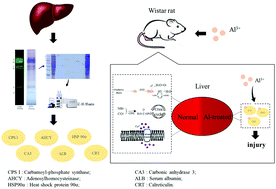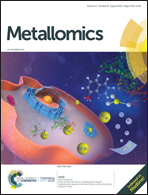Study on the mechanism underlying Al-induced hepatotoxicity based on the identification of the Al-binding proteins in liver
Abstract
Aluminum (Al) is the most abundant metal element in the earth's crust, and is implicated in the pathogenesis of liver lesions. However, the mechanisms underlying Al3+-induced hepatotoxicity are still largely elusive. Based on analysis with native gel electrophoresis, Al3+ plus 8-hydroxyquinoline staining and LC-MS/MS, the proteins with high Al3+ affinity were identified to be carbamoyl-phosphate synthase, adenosylhomocysteinase, heat shock protein 90-alpha, carbonic anhydrase 3, serum albumin and calreticulin. These proteins are involved in physiological processes such as the urea cycle, redox reactions, apoptosis and so on. Then we established an Al3+-treated rat model for biochemical tests, morphology observation and Ca2+ homeostasis analysis, in order to evaluate the extent of oxidative damage, hepatic histopathology and specific indicators of Al3+-related proteins in liver. Our findings indicated the high-affinity interactions with Al3+ perturbed the normal function of the above proteins, which could account for the mechanism underlying Al3+-induced hepatotoxicity.



 Please wait while we load your content...
Please wait while we load your content...